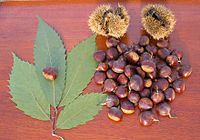
Photo from wikipedia
Abstract The loss of American chestnut (Castanea dentata) in eastern North America to chestnut blight, a disease caused by the fungal pathogen (Cryphonectria parasitica), has devastated ecological and utilitarian processes… Click to show full abstract
Abstract The loss of American chestnut (Castanea dentata) in eastern North America to chestnut blight, a disease caused by the fungal pathogen (Cryphonectria parasitica), has devastated ecological and utilitarian processes and functions. A backcross breeding approach has been developed to confer disease resistance to hybrid seedlings, and forest reintroduction trials will provide important information on performance and durability of resistance in real-world forest conditions. Three plantings were established in 2009 in mesic, even-aged regeneration harvests (site index averaged 23 m for Quercus rubra) and were examined for eight-year blight resistance. These plantings are the first forest field trials to test blight resistance of the most advanced breeding generation currently available, the third generation of the third backcross (BC3F3), against less advanced breeding generations (BC1F3, BC2F3), disease-resistant Chinese chestnut (C. mollissima), and disease-susceptible American chestnut. We also examined if C. parasitica infection was related to tree size and growth. The pathogen infected 36 percent of trees across locations by year 8, but 31 percent of trees died prior to detection of infection. Non-pathogen related mortality was probably due to factors that are typical of hardwood plantings, including repeated deer browsing and native and non-native pest damage. The BC3F3 generation exhibited resistance more similar to the Chinese chestnut than the American chestnut, but exhibited significantly lower resistance than Chinese chestnut at the location with the highest blight incidence; genetic family differences among BC3F3 progeny were significant at this location. Interactions between planting location and breeding generation affected resistance rankings, suggesting additional or longer-term testing is needed to determine resistance of a particular breeding line across a variety of sites. Probability of disease incidence was positively related to ground-line diameter (GLD), but this relationship depended on location and breeding type. At two locations, American chestnut had 50 percent probability of C. parasitica infection when GLD was approximately 70 mm, and the BC3F3 had 50 percent probability when GLD was between 93 and 126 mm. The Chinese chestnut maintained low probability of disease incidence (
Journal Title: Forest Ecology and Management
Year Published: 2019
Link to full text (if available)
Share on Social Media: Sign Up to like & get
recommendations!